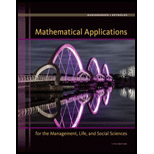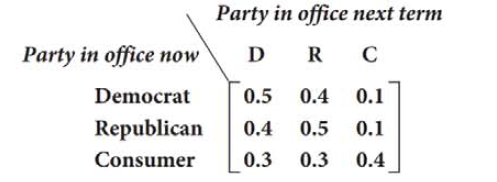
Politics Use the following information for Problems 21 and 22. In a certain city, the Democratic, Republican, and Consumer parties have members of their parties on the city council. The probability of a member of this party winning any election depends on the proportional membership of his or her party at the time of the election. The probabilities for all these parties winning are given by the following transition matrix P.

Using the given transition matrix and assuming that the initial probability vector is
Want to see the full answer?
Check out a sample textbook solution
Chapter 7 Solutions
Mathematical Applications for the Management, Life, and Social Sciences
- Consumer Preference In a population of 100,000 consumers, there are 20,000 users of Brand A, 30,000 users of Brand B, and 50,000 who use neither brand. During any month, a Brand A user has a 20 probability of switching to Brand B and a 5 of not using either brand. A Brand B user has a 15 probability of switching to Brand A and a 10 probability of not using either brand. A nonuser has a 10 probability of purchasing Brand A and a 15 probability of purchasing Brand B. How many people will be in each group a in 1 month, b in 2 months, and c in 18 months?arrow_forwardIf a game gives payoffs of $10 and $100 with probabilities 0.9 and 0.1, respectively, then the expected value of this game is E=0.9+0.1= .arrow_forward
 Elementary Linear Algebra (MindTap Course List)AlgebraISBN:9781305658004Author:Ron LarsonPublisher:Cengage Learning
Elementary Linear Algebra (MindTap Course List)AlgebraISBN:9781305658004Author:Ron LarsonPublisher:Cengage Learning Holt Mcdougal Larson Pre-algebra: Student Edition...AlgebraISBN:9780547587776Author:HOLT MCDOUGALPublisher:HOLT MCDOUGALAlgebra & Trigonometry with Analytic GeometryAlgebraISBN:9781133382119Author:SwokowskiPublisher:Cengage
Holt Mcdougal Larson Pre-algebra: Student Edition...AlgebraISBN:9780547587776Author:HOLT MCDOUGALPublisher:HOLT MCDOUGALAlgebra & Trigonometry with Analytic GeometryAlgebraISBN:9781133382119Author:SwokowskiPublisher:Cengage College AlgebraAlgebraISBN:9781305115545Author:James Stewart, Lothar Redlin, Saleem WatsonPublisher:Cengage Learning
College AlgebraAlgebraISBN:9781305115545Author:James Stewart, Lothar Redlin, Saleem WatsonPublisher:Cengage Learning



